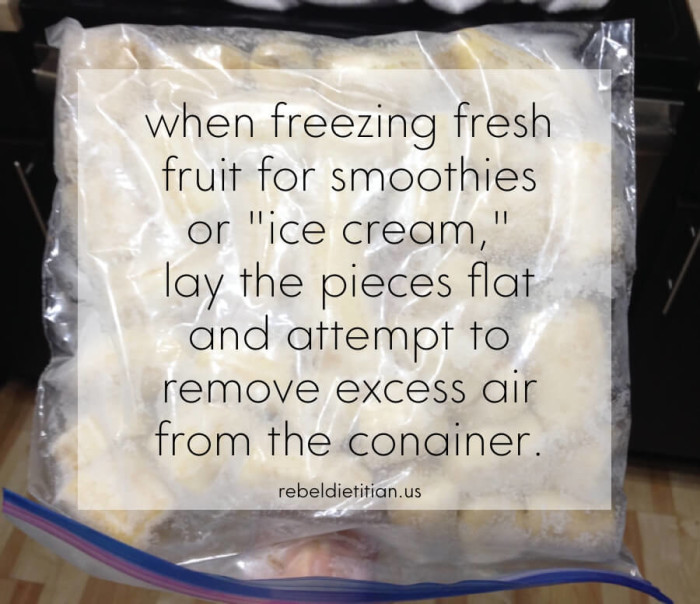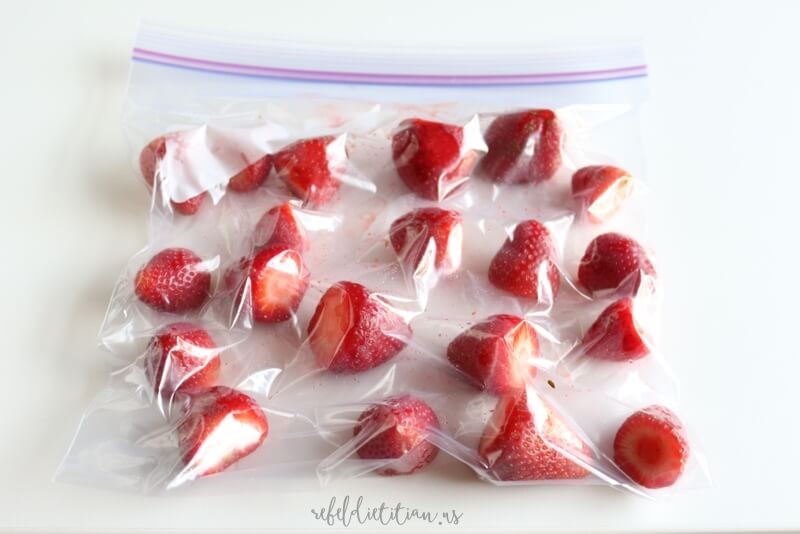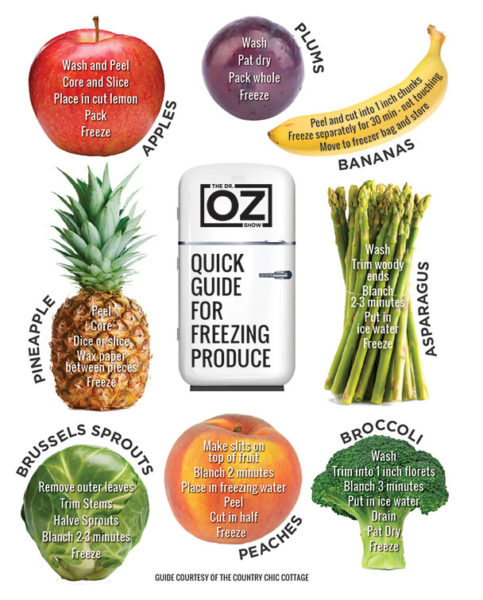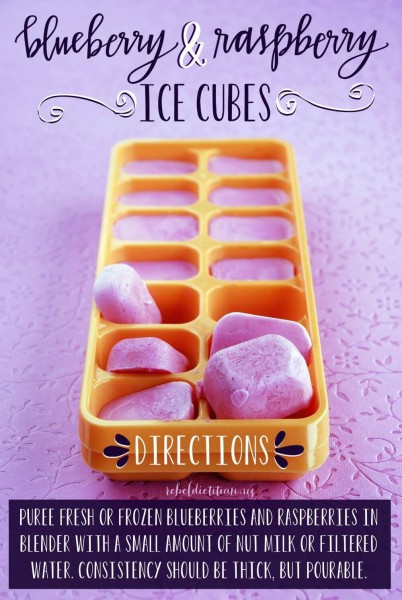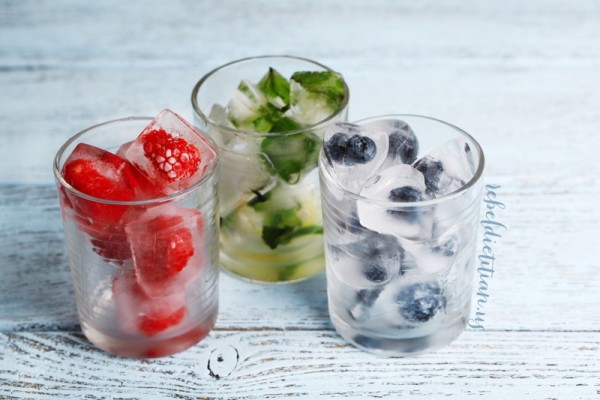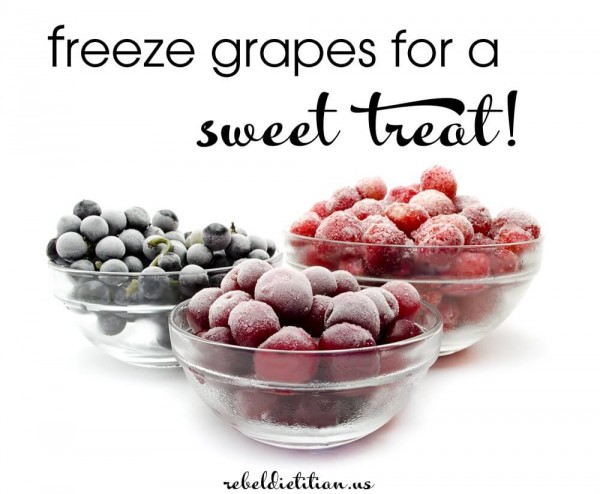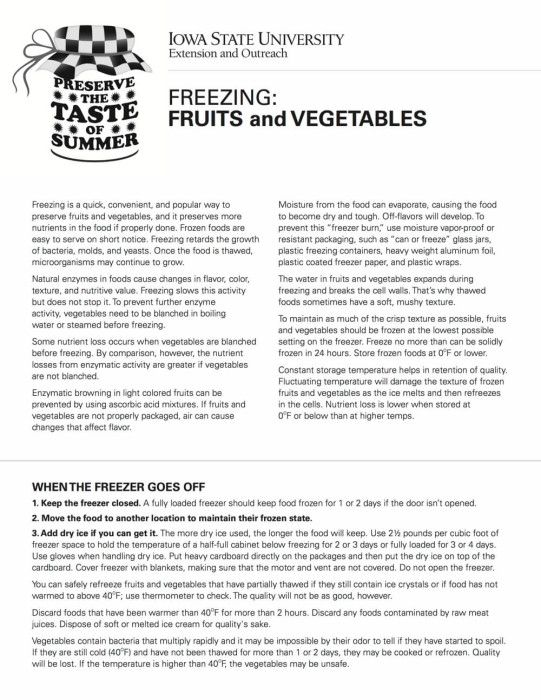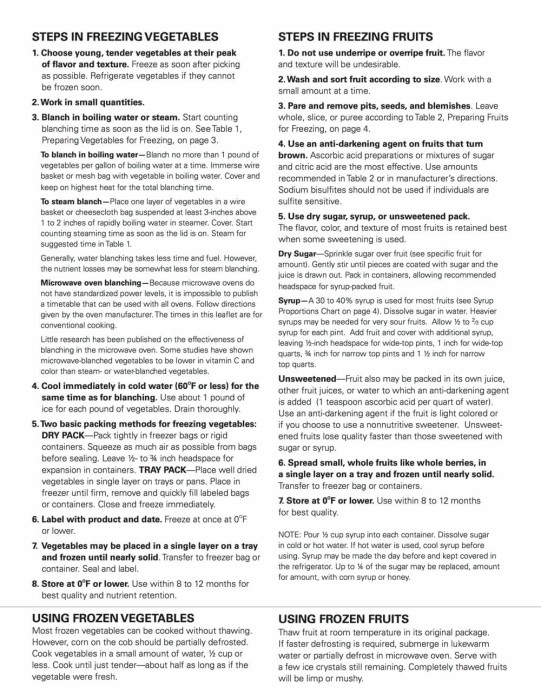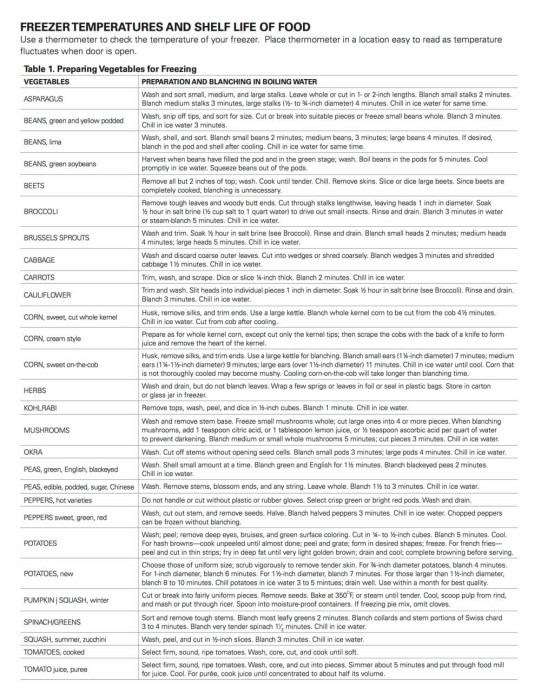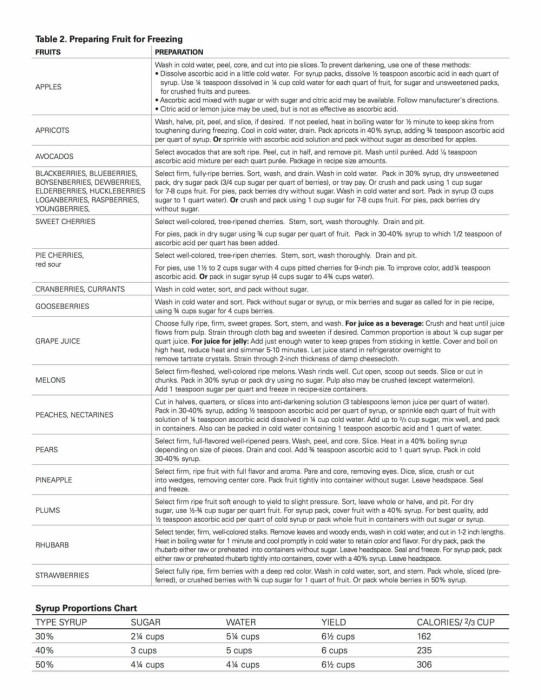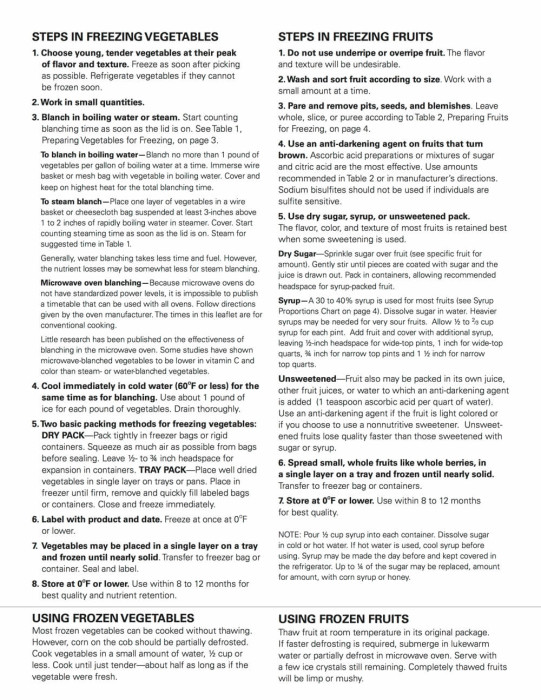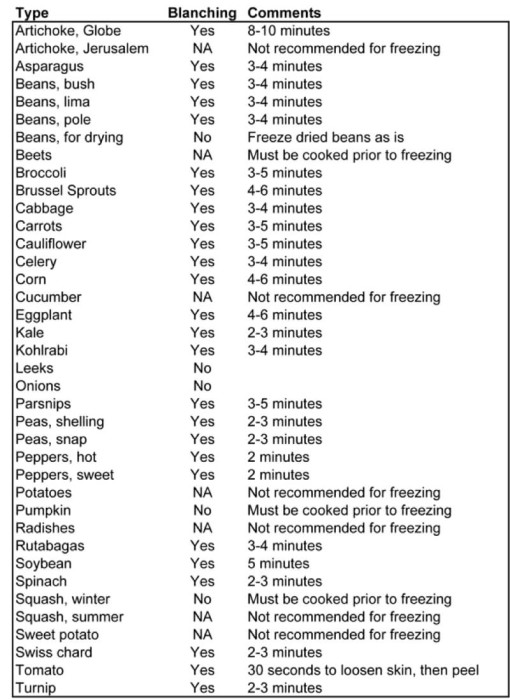Frozen produce can be used safely as ingredients in a wide variety of recipes including smoothies, soups, spaghetti sauce, baby food, applesauce, and baked goods. If you notice your produce is about to spoil, don’t let it go to waste! Prep it and freeze it to use at a later date using an air tight container or even ice cube trays.
Freezing Basics
Is it necessary to leave headspace in packages to be frozen?
Yes, with the exception of vegetables that pack loosely (e.g. broccoli and asparagus). Leaving headspace ensures space for the food to expand during the freezing process.
At what temperature should the freezer be maintained?
0°F or less.
How long will food remain frozen if the power goes off?
Foods stay frozen longer if the freezer remains unopened, is full, is in a cool place and is well insulated. In general, food stored in a full freezer will stay frozen for 2 to 4 days. A half-filled freezer may only last 24 hours. To provide additional coverage, consider covering your freezer with blankets.
Can food be refrozen if it has thawed?
Foods can be refrozen if at least one of these two conditions are met: 1) Foods have only partially thawed and still have ice crystals in the package; 2) The freezer temperature has remained at 40°F or below. Before using, check to see that color and odor of the food are good. Quality of the food will be lower.
What is freezer burn?
It is dehydration or drying that occurs on the surface of a frozen product if it is improperly wrapped. The food is safe to eat but poorer quality. To prevent freezer burn, the package must be free of air and sealed airtight.
Does freezing improve the quality of food?
Freezing does not improve the quality of the product. Frozen food is only as good as the quality of the fresh food. So, select only high quality products at optimum maturity and freshness.
Does freezing kill germs?
Freezing does not kill bacteria and other microorganisms, but it will delay their multiplication when the temperature is held at 0°F or less. Upon thawing the food, the surviving organisms can multiply again.
How much food can be frozen at one time?
Add only the amount that will freeze within 24 hours, which is usually two or three pounds of food per cubic foot of storage space. Overloading your freezer will delay the freezing rate.
Will food spoil if the freezer temperature is above 0°F?
Food may not spoil but the quality (color, flavor, and texture) will decrease. The higher the temperature, the faster the product will deteriorate.
Will food spoil if it is stays frozen longer than the recommended storage time?
Not necessarily. The recommended storage time is the time in which food should be used to ensure maximum flavor, taste, and texture. Food stored longer than the recommended time will experience losses of flavor, color, and texture.
How can you be sure that your freezer is at 0°F or less?
Purchase a freezer thermometer, keep it in the freezer and check the temperature regularly.
Will it pay to buy a freezer?
A freezer is usually more of a convenience than a saving. To make the best use of it, (1) keep the freezer full, (2) use and replace the food, do not just store it, and (3) use older food first.
Is a chest or upright freezer best?
This depends on personal preference as well as available floor space. Generally speaking, the upright freezer is easier to organize and takes up less floor space. Chest freezers, however, are usually more economical to operate.
Storage Containers
What kind of packaging materials should be used for freezing?
Safe freezing materials include wide-mouth dual purpose glass jars, stainless steel, or heavily waxed cardboard.
Can glass jars be used for freezing?
Regular glass jars break easily at freezer temperatures. If using glass jars, choose wide-mouth dual purpose jars made for freezing and canning; these jars have been tempered to withstand extremes in temperatures. If standard canning jars (those with narrow mouths) are used, leave extra headspace in liquid packs (3/4-inch for pints; 11/2-inches for quarts) to allow for expansion of food during freezing and completely thaw food before removing it. Do not use regular canning jars for foods packed in water.
Can aluminum foil be used as a freezer wrap?
No, aluminum foil is not recommended for freezing. Heavy duty aluminum foil can be used as a freezer wrap; however, this is not recommended because it tears easily.
Is wax paper a suitable freezer wrap?
No, wax paper is not moisture-vapor resistant.
Can bread wrappers be used for freezing?
No, bread wrappers are not sufficiently moisture-vapor resistant to be used for freezing.
Can zip-type bags be used for freezing?
Yes, if they have been designed for and their box marked for freezer use.
Can milk cartons be used for freezing foods?
No, cardboard cartons for cottage cheese, ice cream or milk are not sufficiently moisture-vapor resistant to be suitable for long term freezer storage.
Remove Extra Air
For best results, freeze produce in smaller batches and remove any extra air remaining in the container to prevent the formation of ice crystals. If possible, leave a little bit of space between the individual pieces of produce in order to avoid creating a huge chunk of ice that is difficult to separate. After bagging your produce, lay the container flat on a shelf – or a tray – until frozen solid. Once frozen, you can move the container to a freezer drawer, if desired. See the images below for a visual.
Freezing Fruit
Is it safe to freeze fruit without sugar?
Yes; I never add sugar when preparing produce for freezing; however, it may be used to preserve flavor, color and texture.
How do you prevent fruit from turning brown during freezing?
Ascorbic acid, citric acid, and/or lemon juice is frequently used.
Why are frozen fruits sometimes soft when thawed?
If fruits are frozen slowly large ice crystals form and rupture cell walls causing a soft mushy product. For best results, quick freeze at -10°F and serve just as ice crystals are disappearing.
Source: The National Center for Home Food Preservation (NCHFP)
Freezing Berries
Strawberries
Wash your strawberries carefully in cold water and pat dry. Remove the stems and any soft spots. Pack the berries into freezable containers, or freeze them on a baking sheet and then pack them into containers as soon as they are frozen. Seal the container and keep frozen until you are ready to use them.
Raspberries and Blackberries
Raspberries and blackberries are very fragile and fresh raspberries are very sensitive to freeze damage. To freeze raspberries and blackberries rinse them gently in cool water then allow them to dry in a colander or on paper towels. Place a sheet of wax paper on a baking sheet then place the berries in the freezer. After the berries are frozen, pack them into sealed containers until you are ready to use them. By freezing the berries this way, they won’t stick to each other which allows you to easily measure out the needed amount once you are ready to use them.
Blueberries
If you plan to freeze your blueberries, do not wash them before freezing as doing so will make the blueberry skins tough. Instead pack your blueberries into freezable containers, or freeze them on a baking sheet and then pack them into containers as soon as they are frozen. Seal the container and keep frozen until you are ready to use them. Be sure to wash the thawed blueberries prior to use.
Source: Driscoll’s Food Service
Freezing Vegetables
What is blanching?
Dipping or submerging the vegetables in boiling water or steam for a short period of time prior to freezing.
Is it recommended to blanch vegetables before freezing?
According to the HFP, blanching reduces loss of flavor, color, texture, and nutrient content. It also provides extra protection against bacterial contamination. However, it isn’t mandatory. I create ice cubes from leafy greens and a small amount of water without blanching them and they turn out fine.
How do you blanch vegetables?
Use a wire blanching basket and covered saucepan, or fit a wire basket into a large kettle with fitted lid. Use one gallon of water per pound of prepared vegetable. Put vegetable in blanching basket and lower it into vigorously boiling water. Place lid on blancher and start counting blanching time as soon as the water returns to a boil. Keep the heat on high throughout the blanching period. The water should return to boiling within 1 minute. If not, the ratio of vegetables to water is excessive. Use less vegetables or increase the water content.
Why is it necessary to cool vegetables after blanching?
Vegetables should be cooled quickly and thoroughly after blanching to stop the cooking process. Otherwise, vegetables will be overcooked with loss of flavor, color, vitamins and minerals.
What causes frost or ice crystals to appear on the surface of frozen vegetables such as broccoli?
Inadequate draining of vegetables before freezing, slow freezing or fluctuation of storage temperatures above 0°F may cause undesirable formation of large and excessive ice crystals. This can affect the texture as well as appearance of frozen vegetables.
Can I blanch in my microwave oven?
Microwave blanching may not be as effective as other methods, since research has shown that some enzymes may not be inactivated. This could result in off flavors and loss of texture and color. Those wishing to run the risk of low quality vegetables by microwave blanching should be sure to work in small quantities, using the directions for their specific microwave oven. Microwave blanching will not save time or energy.
Can vegetables be fully cooked before freezing?
Some fully cooked vegetables, such as baked beans and candied sweet potatoes, maintain high quality for many months when frozen. Most fully cooked vegetables, however, have less desirable color, aroma and flavor when reheated. Loss of flavor may be retarded by covering the vegetable with cooking liquid, meat broth or cream sauce.
Does it matter how long vegetables are blanched?
Blanching time is crucial and varies with the vegetables and size. Under-blanching stimulates the activity of enzymes and is worse than no blanching. Over-blanching causes loss of color, flavor, vitamins and minerals.
Are frozen vegetables safe to eat if they are not blanched?
Yes. They are safe to eat, but the quality (color, flavor and texture) will be poorer than that of vegetables which have been blanched. Blanching slows or stops the action of enzymes which cause loss of flavor, color and texture.
How can you prevent corn-on-the-cob from tasting weird?
After blanching ears for the recommended time, chill immediately with ice water until the cobs are completely cold. Partially thaw the ears of corn before cooking.
Should frozen vegetables be thawed before cooking?
For most vegetables, no. You get a fresher tasting product if it has not been thawed. Exceptions are corn-on-the cob and leafy greens which cook more evenly if partially thawed first.
Is it necessary to wash peas and lima beans before shelling?
Any vegetable should be washed before shelling to remove any foreign material such as dirt, insects, leaves, etc.
Learn More
Rebel Lifestyle
To learn more about my lifestyle, click here.
Rebel Grub
To view photos of my clean and green grub, click here.
Posters and Charts
To view my nutrition posters and charts, click here.
Shopping Lists
To view my shopping lists, click here.
Meal Planning
To view meal planning information and inspiration, click here.
FAQs
To view the answers to my frequently asked questions, visit the page titled FAQs.
Pinterest and Facebook
Don’t forget to follow me on Pinterest and/or Facebook! Big hugs! xo, Dana
Posters and Charts
Except where otherwise noted, content on this site is licensed under a CC BY-NC-ND 4.0 license. This means you are free to use my work for personal use (e.g., save the file to your computer or share via social media) as long as you do not use the image for commercial purposes. Big hugs! Dana
 Rebel Dietitian Dana McDonald, RD
Rebel Dietitian Dana McDonald, RD 